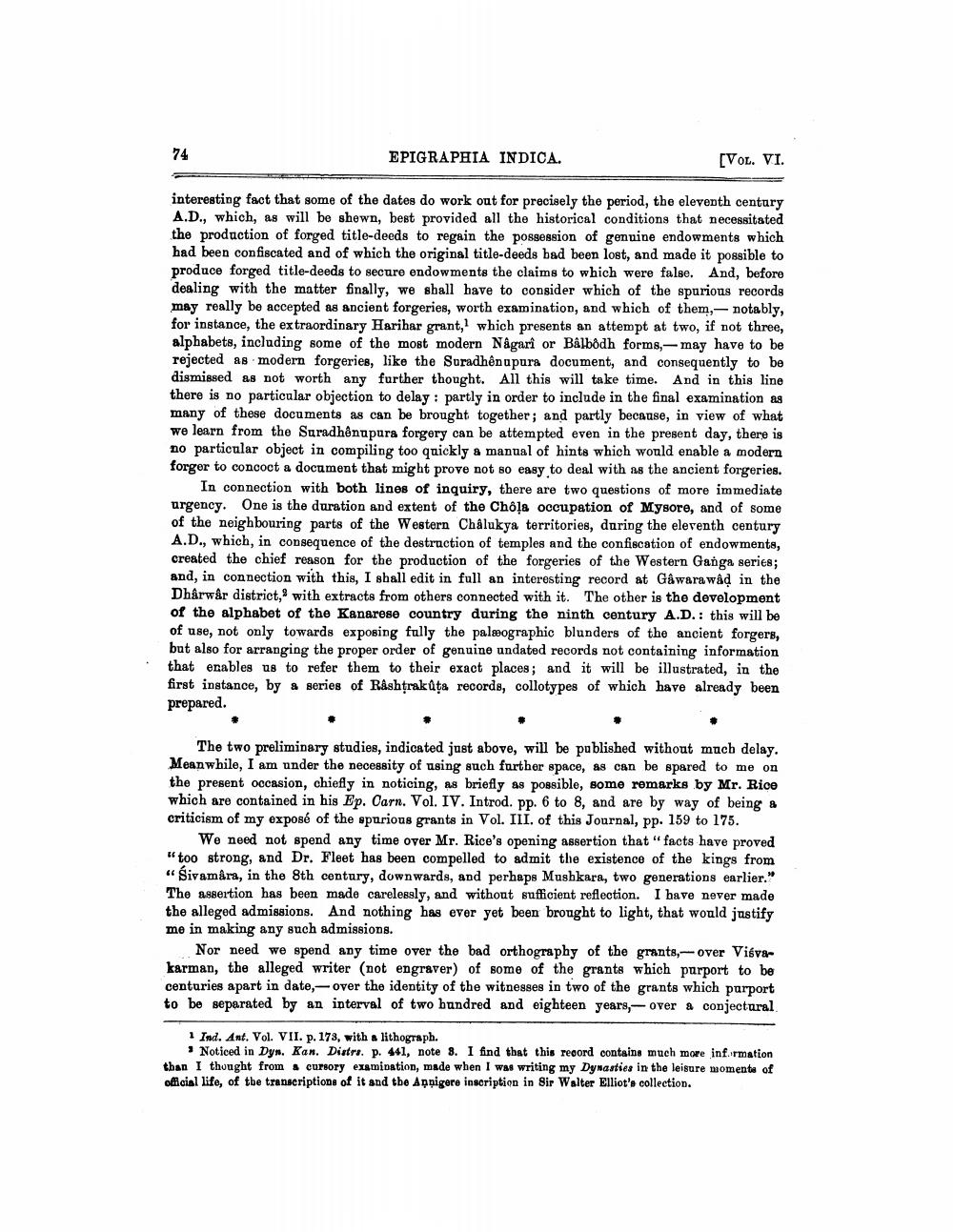________________
74
EPIGRAPHIA INDICA.
interesting fact that some of the dates do work out for precisely the period, the eleventh century A.D., which, as will be shewn, best provided all the historical conditions that necessitated the production of forged title-deeds to regain the possession of genuine endowments which had been confiscated and of which the original title-deeds had been lost, and made it possible to produce forged title-deeds to secure endowments the claims to which were false. And, before dealing with the matter finally, we shall have to consider which of the spurious records may really be accepted as ancient forgeries, worth examination, and which of them, notably, for instance, the extraordinary Harihar grant, which presents an attempt at two, if not three, alphabets, including some of the most modern Nâgari or Bâlbôdh forms,- may have to be rejected as modern forgeries, like the Suradhênupura document, and consequently to be dismissed as not worth any further thought. All this will take time. And in this line there is no particular objection to delay: partly in order to include in the final examination as many of these documents as can be brought together; and partly because, in view of what we learn from the Suradhênupura forgery can be attempted even in the present day, there is no particular object in compiling too quickly a manual of hints which would enable a modern forger to concoct a document that might prove not so easy to deal with as the ancient forgeries.
[VOL. VI.
In connection with both lines of inquiry, there are two questions of more immediate urgency. One is the duration and extent of the Chôla occupation of Mysore, and of some of the neighbouring parts of the Western Châlukya territories, during the eleventh century A.D., which, in consequence of the destruction of temples and the confiscation of endowments, created the chief reason for the production of the forgeries of the Western Ganga series; and, in connection with this, I shall edit in full an interesting record at Gâwarawâḍ in the Dharwâr district, with extracts from others connected with it. The other is the development of the alphabet of the Kanarese country during the ninth century A.D.: this will be of use, not only towards exposing fully the paleographic blunders of the ancient forgers, but also for arranging the proper order of genuine undated records not containing information that enables us to refer them to their exact places; and it will be illustrated, in the first instance, by a series of Rashtrakûța records, collotypes of which have already been prepared.
The two preliminary studies, indicated just above, will be published without much delay. Meanwhile, I am under the necessity of using such further space, as can be spared to me on the present occasion, chiefly in noticing, as briefly as possible, some remarks by Mr. Rice which are contained in his Ep. Carn. Vol. IV. Introd. pp. 6 to 8, and are by way of being a criticism of my exposé of the spurious grants in Vol. III. of this Journal, pp. 159 to 175.
We need not spend any time over Mr. Rice's opening assertion that "facts have proved "too strong, and Dr. Fleet has been compelled to admit the existence of the kings from "Sivamâra, in the 8th century, downwards, and perhaps Mushkara, two generations earlier." The assertion has been made carelessly, and without sufficient reflection. I have never made the alleged admissions. And nothing has ever yet been brought to light, that would justify me in making any such admissions.
Nor need we spend any time over the bad orthography of the grants,-over Visvakarman, the alleged writer (not engraver) of some of the grants which purport to be centuries apart in date,-over the identity of the witnesses in two of the grants which purport to be separated by an interval of two hundred and eighteen years, over a conjectural
1 Ind. Ant. Vol. VII. p. 173, with a lithograph.
Noticed in Dyn. Kan. Distrs. p. 441, note 8. I find that this record contains much more information than I thought from a cursory examination, made when I was writing my Dynasties in the leisure moments of official life, of the transcriptions of it and the Appigere inscription in Sir Walter Elliot's collection.




